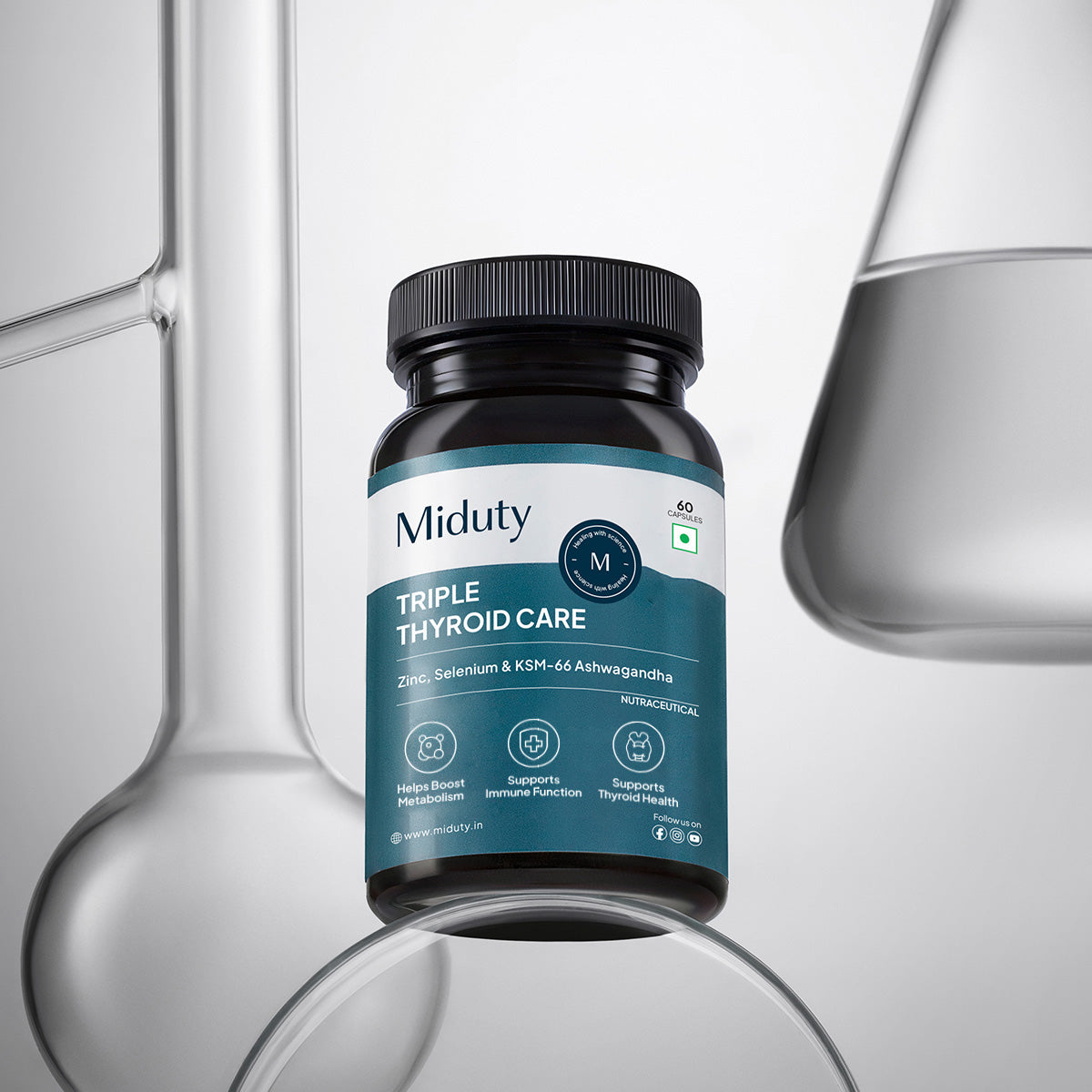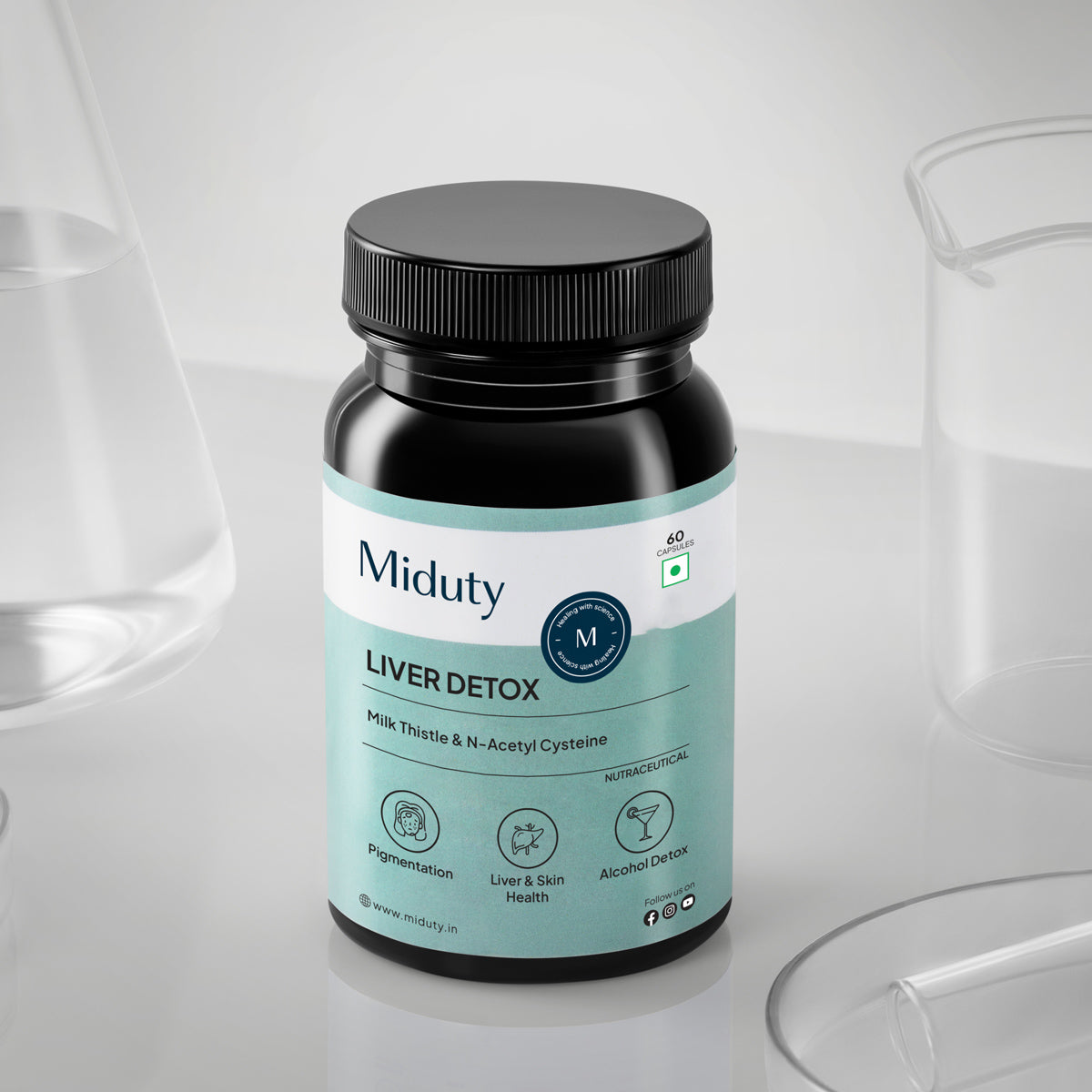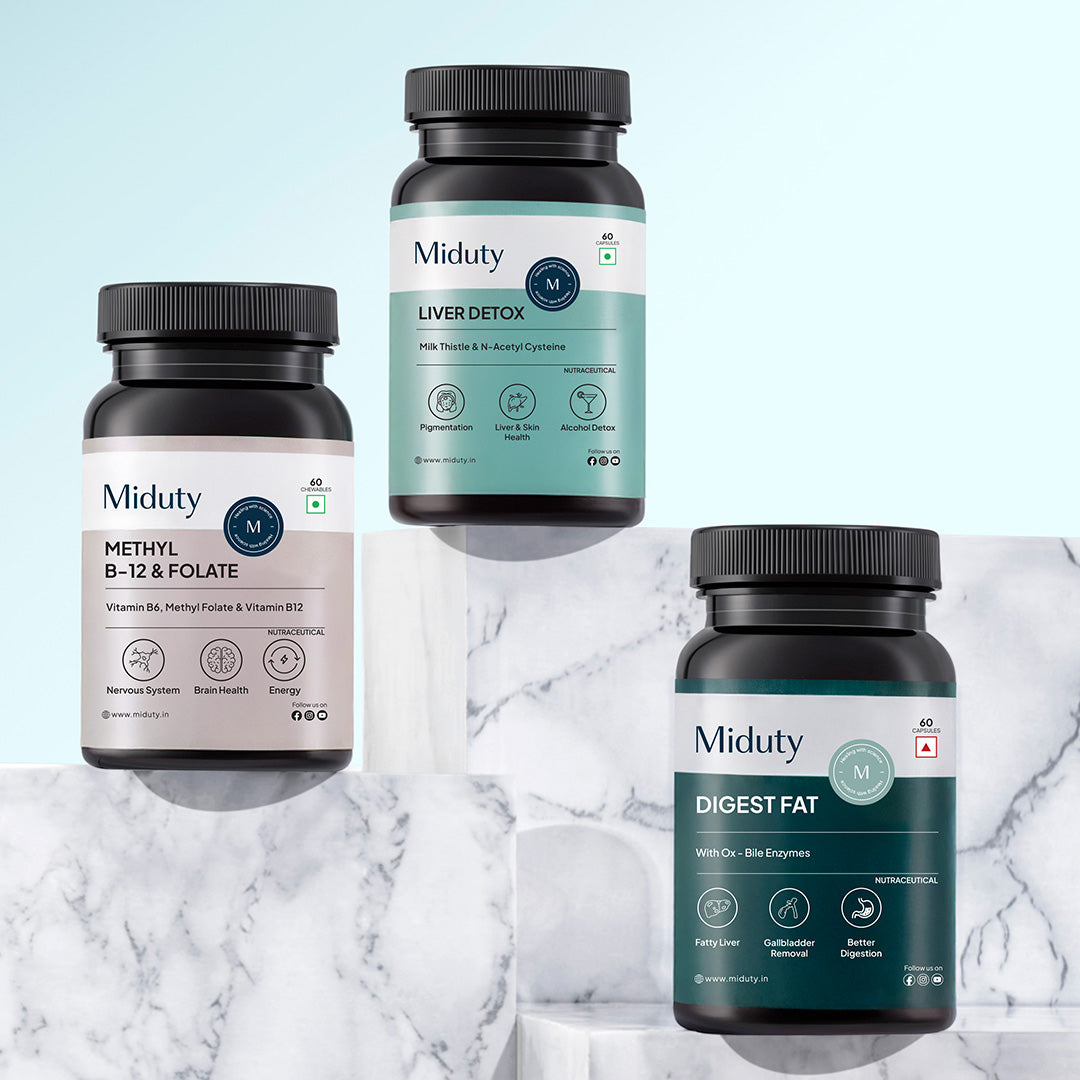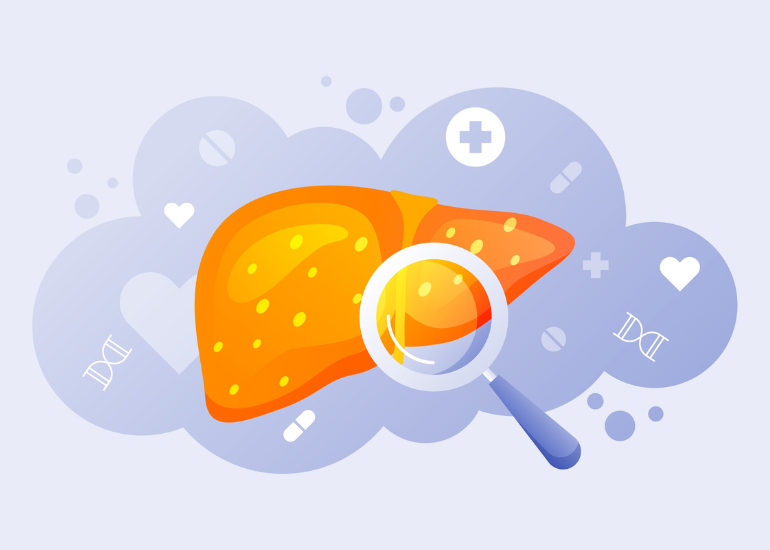
The Link Between Hypothyroidism and Non Alcoholic Fatty Liver Disease
Introduction
A study conducted at a hospital in India found that 16.8% of patients with non-alcoholic fatty liver disease (NAFLD) had hypothyroidism, compared to only 1.3% in the control group.
Key Takeaways
1. Thyroid Trouble Can Trigger Fatty Liver. Even without obesity or alcohol, low thyroid hormones increase your risk of NAFLD, it's a hidden connection backed by research.
2. Two Conditions, One Root Problem: Metabolic Slowdown. Hypothyroidism and NAFLD both slow fat metabolism, increase inflammation, and worsen insulin resistance.
3. Fatigue, Weight Gain, and Liver Trouble? If you're tired, gaining weight, and have elevated liver enzymes, your thyroid might be silently damaging your liver.
4. Liver-Friendly Thyroid Support Exists. A supplement blend of L-Tyrosine, Iodine, Milk Thistle, and NAC can support both thyroid hormone production and liver detox.
5. Treat Both, Heal Better. Managing thyroid levels + lifestyle changes for NAFLD = double protection for your metabolism, energy, and long-term health.
If you've been diagnosed with hypothyroidism or nonalcoholic fatty liver disease (NAFLD), you might be wondering: are these two conditions related? Surprisingly, the answer is yes. Both conditions affect your metabolism, and when combined, they can amplify each other's negative impacts on your health. In this article, we'll explore the connection between hypothyroidism and NAFLD, how they influence each other, and what you can do to manage these conditions together.
What is Hypothyroidism?
Hypothyroidism is a condition where your thyroid gland doesn't produce enough thyroid hormones. These hormones, primarily T3 (triiodothyronine) and T4 (thyroxine), play a critical role in regulating your metabolism, energy production, and various bodily functions. When your thyroid is underactive, it can slow down numerous systems in your body, leading to symptoms such as fatigue, weight gain, depression, and sensitivity to cold.
Hypothyroidism is commonly caused by autoimmune diseases like Hashimoto's thyroiditis, iodine deficiency, or surgical removal of the thyroid gland. It is more common in women and tends to increase with age.
What is Nonalcoholic Fatty Liver Disease (NAFLD)?
Nonalcoholic fatty liver disease (NAFLD) refers to the buildup of excess fat in the liver that is not caused by alcohol consumption. It is a common liver condition that can lead to more severe liver damage if not addressed. NAFLD is closely linked to metabolic risk factors such as obesity, type 2 diabetes, and insulin resistance.
NAFLD can progress to nonalcoholic steatohepatitis (NASH), which involves inflammation and liver cell damage, eventually leading to cirrhosis or liver failure. This progression makes it crucial to address NAFLD early on to prevent long-term liver damage.
How Hypothyroidism Affects the Liver?
1. Thyroid Hormones and Liver Function
Thyroid hormones have a significant role in regulating the liver's metabolic functions. Hypothyroidism can lead to a decrease in the liver's ability to metabolize fats and eliminate toxins. This reduction in liver function may contribute to the accumulation of fat in the liver, a hallmark of NAFLD.
2. Thyroid Hormone Deficiency and Fatty Liver Risk
Studies show that people with hypothyroidism are more likely to develop fatty liver disease. The lack of thyroid hormones slows down fat metabolism, making it easier for fat to accumulate in the liver. Additionally, hypothyroidism can impair the liver's ability to handle oxidative stress, which can further contribute to liver damage.
The Link Between Hypothyroidism and NAFLD
1. Increased Prevalence of NAFLD in Hypothyroid Patients
Research indicates that patients with hypothyroidism are at a higher risk of developing NAFLD. A study published in the Journal of Clinical Endocrinology & Metabolism found that individuals with low thyroid hormone levels had a higher incidence of fatty liver, regardless of their weight or alcohol consumption. This suggests that the thyroid-hormone-fatty liver connection is not merely related to obesity or lifestyle choices.
2. Hypothyroidism's Role in Metabolic Syndrome and NAFLD
Metabolic syndrome is a cluster of conditions that include high blood pressure, high blood sugar, excess abdominal fat, and abnormal cholesterol levels. Hypothyroidism is closely linked to the development of metabolic syndrome, and individuals with this syndrome are at a significantly higher risk of developing NAFLD. This relationship is further compounded by the fact that both hypothyroidism and NAFLD are associated with insulin resistance, a key factor in the progression of both conditions.
3. Inflammation and Fat Metabolism
Both hypothyroidism and NAFLD are characterized by low-grade inflammation. In hypothyroid patients, the imbalance of thyroid hormones can lead to increased levels of inflammatory cytokines. This inflammatory response may exacerbate liver damage and fat accumulation. Additionally, the liver's ability to metabolize fat becomes impaired due to reduced thyroid hormone activity, further fueling the development of NAFLD.
Symptoms of Hypothyroidism and NAFLD
|
Hypothyroidism |
Non-Alcoholic Fatty Liver |
|
Unexplained Weight Gain |
Fatigue |
|
Fatigue and Weakness |
Abdominal Discomfort |
|
Cold Intolerance |
Elevated Liver Enzymes |
|
Dry Skin and Hair |
Unexplained Weight Gain or Difficult Losing Weight |
|
Depression |
Jaundice |
|
Constipation |
While these symptoms are not always specific, a combination of them might indicate the presence of both conditions. Early diagnosis and treatment are essential to managing both hypothyroidism and NAFLD.
Diagnosing Hypothyroidism and NAFLD
Hypothyroidism is usually diagnosed through blood tests that measure levels of thyroid hormones (T3, T4) and thyroid-stimulating hormone (TSH). Elevated TSH levels with low T3 and T4 levels indicate hypothyroidism.
NAFLD is often diagnosed through imaging tests such as ultrasound, CT scans, or MRIs, which can detect fat accumulation in the liver. Blood tests measuring liver enzymes and a biopsy (in more severe cases) can also be used to confirm the diagnosis and assess the extent of liver damage.
Managing Hypothyroidism and NAFLD Together
The primary treatment for hypothyroidism is thyroid hormone replacement therapy, usually in the form of levothyroxine. This medication helps normalize thyroid hormone levels and restore proper metabolism. Once thyroid levels are balanced, many symptoms of hypothyroidism, including those that contribute to weight gain and fatigue, may improve.
For NAFLD, the first line of treatment is lifestyle modification, particularly weight loss and improving diet. Eating a balanced diet, avoiding processed foods and excessive sugar, and increasing physical activity can help reduce fat buildup in the liver. For individuals with both hypothyroidism and NAFLD, managing both conditions through a holistic approach is essential for optimal health.
While there are no FDA-approved medications specifically for NAFLD, several medications may be used off-label to help manage the condition. Medications to control blood sugar and improve insulin sensitivity, such as metformin, may be beneficial for patients with NAFLD. Additionally, certain supplements like vitamin E have been shown to reduce liver inflammation and fat accumulation in some patients.
Best Supplements for Thyroid and NAFLD
A supplement combining L-Tyrosine, Iodine, Milk Thistle, and N-Acetylcysteine (NAC) supports both thyroid and liver health. L-Tyrosine aids in thyroid hormone production, while Iodine is crucial for thyroid function. Milk Thistle detoxifies the liver, and NAC boosts glutathione levels, helping to protect cells from oxidative stress, promoting overall well-being and enhanced metabolic function.
Preventing the Development of Both Conditions
Though not all cases of hypothyroidism can be prevented, maintaining a healthy diet and lifestyle, managing autoimmune diseases, and ensuring adequate iodine intake can help reduce the risk of developing hypothyroidism.
The best prevention for NAFLD involves maintaining a healthy weight, regular exercise, and a balanced diet rich in fiber, antioxidants, and healthy fats. Managing blood sugar levels and reducing alcohol intake can also help prevent the onset of NAFLD.
Conclusion
Hypothyroidism and nonalcoholic fatty liver disease are both serious conditions that can negatively impact your overall health. They are more interconnected than many realize, with hypothyroidism potentially contributing to the development and progression of NAFLD. By understanding the link between these two conditions and taking proactive steps in terms of diagnosis, treatment, and lifestyle changes, individuals can manage both conditions effectively. Whether you're struggling with hypothyroidism, NAFLD, or both, it's essential to work with a healthcare provider to develop a comprehensive treatment plan that addresses all aspects of your health.
Frequently Asked Questions on Hypothyroidism and NAFLD
Q1 - Can hypothyroidism cause NAFLD?
Yes, hypothyroidism can contribute to the development of nonalcoholic fatty liver disease by impairing fat metabolism and promoting fat accumulation in the liver.
Q2 - What lifestyle changes are recommended for managing both conditions?
A healthy diet, regular physical activity, weight loss, and managing blood sugar levels are key strategies for managing both hypothyroidism and NAFLD.
Q3 - Can thyroid hormone replacement therapy improve NAFLD?
While thyroid hormone replacement can help improve thyroid function and metabolism, it is not a specific treatment for NAFLD. Managing NAFLD requires lifestyle changes and possibly medications.
Q4 - How do I know if I have both hypothyroidism and NAFLD?
Diagnosis is made through blood tests (for hypothyroidism) and imaging or liver enzyme tests (for NAFLD). If you have symptoms of both, it's crucial to get checked by a healthcare provider.
Q5 - Is there a cure for NAFLD?
Currently, there is no cure for NAFLD, but it can be managed and even reversed with lifestyle changes like weight loss, exercise, and a healthy diet.
References












